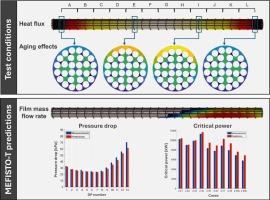Three-Field subchannel modeling of CANDU fuel thermal-hydraulics with MEFISTO-T code
IF 2.1
3区 工程技术
Q1 NUCLEAR SCIENCE & TECHNOLOGY
引用次数: 0
Abstract
To support the development and validation of core thermal–hydraulic simulation codes, OECD/NEA organized a benchmark focused on thermal–hydraulic behavior of CANDU fuel assemblies. The benchmark was based on full-scale heat transfer experiments conducted in a 28-element horizontal test bundle, covering conditions representative of CANDU core operations. A non-blind phase was included, providing a limited set of axial pressure drop (single-phase and two-phase) and critical power data, followed by a blind phase for predictive assessment. The tested geometries simulated CANDU pressure tubes under both uncrept and crept (i.e., aging) conditions, as well as two different bearing pad heights. The crept geometry introduces a significant bypass on the upper side of the rod bundle, associated with complex crossflows that are notoriously challenging to capture by simulation codes. The Westinghouse MEFISTO-T subchannel analysis code, employing a mechanistic three-field model of annular two-phase flow and originally developed for BWR fuel applications, was applied to simulate all benchmark cases. The code calibration parameters related to form loss and drop deposition enhancement due to structural components were adjusted based on the provided dataset. For the non-blind phase, the code accurately predicts axial pressure drop and critical power, and correctly identifies the dryout rod and orientation, although with a downstream bias in axial location. Further results from the blind phase demonstrate generally good agreement, particularly in capturing the effect of pressure tube creep on axial pressure drop and the influence of system parameters (pressure, mass flow rate and inlet temperature) on critical power. However, the significant reduction in critical power observed in the tests due to pressure tube creep and lower bearing pad height was underpredicted, indicating areas for further model refinement. These results highlight the strong potential of applying the MEFISTO-T three-field model to CANDU fuel geometry, while also revealing opportunities for further improvements.

基于MEFISTO-T代码的CANDU燃料热工三场子通道建模
为了支持核心热工模拟代码的开发和验证,OECD/NEA组织了一个关注CANDU燃料组件热工性能的基准。该基准是基于在28个单元的水平测试束中进行的全尺寸传热实验,涵盖了CANDU核心操作的代表性条件。其中包括一个非盲相,提供一组有限的轴向压降(单相和两相)和临界功率数据,然后是一个盲相用于预测评估。测试的几何形状模拟了无蠕变和蠕变(即老化)条件下的CANDU压力管,以及两种不同的轴瓦高度。爬行的几何形状在抽油杆束的上部引入了一个重要的旁路,这与复杂的横流有关,众所周知,通过模拟代码很难捕获。Westinghouse MEFISTO-T子通道分析代码采用了环形两相流的机制三场模型,最初是为沸水堆燃料应用而开发的,用于模拟所有基准情况。基于所提供的数据集,调整了与结构部件形成损失和水滴沉积增强相关的代码校准参数。对于非盲阶段,尽管轴向位置存在下游偏置,但该代码能够准确预测轴向压降和临界功率,并正确识别干杆和方向。盲相的进一步结果显示了良好的一致性,特别是在捕捉压力管蠕变对轴向压降的影响以及系统参数(压力、质量流量和入口温度)对临界功率的影响方面。然而,由于压力管蠕变和较低的轴瓦高度,在试验中观察到的临界功率的显着降低被低估了,这表明了进一步改进模型的领域。这些结果突出了MEFISTO-T三场模型应用于CANDU燃料几何结构的巨大潜力,同时也揭示了进一步改进的机会。
本文章由计算机程序翻译,如有差异,请以英文原文为准。
求助全文
约1分钟内获得全文
求助全文
来源期刊

Nuclear Engineering and Design
工程技术-核科学技术
CiteScore
3.40
自引率
11.80%
发文量
377
审稿时长
5 months
期刊介绍:
Nuclear Engineering and Design covers the wide range of disciplines involved in the engineering, design, safety and construction of nuclear fission reactors. The Editors welcome papers both on applied and innovative aspects and developments in nuclear science and technology.
Fundamentals of Reactor Design include:
• Thermal-Hydraulics and Core Physics
• Safety Analysis, Risk Assessment (PSA)
• Structural and Mechanical Engineering
• Materials Science
• Fuel Behavior and Design
• Structural Plant Design
• Engineering of Reactor Components
• Experiments
Aspects beyond fundamentals of Reactor Design covered:
• Accident Mitigation Measures
• Reactor Control Systems
• Licensing Issues
• Safeguard Engineering
• Economy of Plants
• Reprocessing / Waste Disposal
• Applications of Nuclear Energy
• Maintenance
• Decommissioning
Papers on new reactor ideas and developments (Generation IV reactors) such as inherently safe modular HTRs, High Performance LWRs/HWRs and LMFBs/GFR will be considered; Actinide Burners, Accelerator Driven Systems, Energy Amplifiers and other special designs of power and research reactors and their applications are also encouraged.
 求助内容:
求助内容: 应助结果提醒方式:
应助结果提醒方式:


